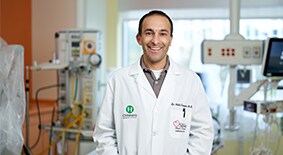Fueling the Brain for a Long and Healthy Life
Studies have shown that a physician’s life expectancy may be determined by actively working to improve and maintain brain health. Joseph K. Williams, MD, a Pediatric Plastic Surgeon, as well as Chief of Plastic and Craniofacial Surgery, and Director of Clinical Research at Children’s Healthcare of Atlanta, shares tips on how physicians can improve cognitive health.
The average retirement age of a physician is between 67 and 74 years old. Of those physicians who leave full-time work, 40% will continue with part-time medical practice. The overall average life expectancy in the U.S. is 79.3 years (females, 81.6 years; males, 76.9 years). That means life will end for 50% of all adults at that age. However, 50% will continue to live, maybe for many more years. College graduates also tend to have a greater than eight-year life expectancy over their counterparts (making up a significant portion of the latter half on the Gaussian curve).
Dementia is defined as the loss of cognitive capacity to the detriment of social functioning and individual living that lasts longer than six months. Though memory loss is an early component of this disorder, other symptoms may include executive functioning, language difficulties, working (immediate) memory, spatial memory and visual memory. The risk of someone getting dementia at 65 years old is 1 in 70. This increases to 1 in 5 by age 85. There are many causes of dementia, the most well-known being Alzheimer’s disease. Alzheimer’s and vascular dementia account for a large percentage of severe-onset dementia cases.
Dementia is not considered the normal process of brain aging. However, it is clear that the normal aging process also demonstrates progressive functional losses in perception, cognition and memory. A growing body of evidence seems to suggest a down-regulation of neuromodulatory system functions and increasingly poor signal-to-noise conditions (getting lost in the process). Traditional thought was that the machinery of thinking simply wore down (Mahncke et al., 2006).
It has been shown that four core biological factors may contribute to normal brain aging:
- Reduced schedules of brain activity (going through the motion)
- Noisy processing (inability to filter)
- Weakened neuromodulatory control
- Negative learning (lack of input)
These combined components may produce “negative” brain plasticity and decrease in function.
The hippocampus and parahippocampal area, key memory regions of the brain, have been shown to decrease in size with age—a normal occurrence (Raz et al., 1998). White matter changes in the brain have also been seen on MRI studies with increasing memory loss (Madden et al., 2009).
Despite these normal physical changes, the brain has the ability to alter its functional capacity throughout life, both in a negative and positive manner. For example, the same group of patients who demonstrated an age-related decrease in size of the hippocampus actually showed a subsequent increase in size with simple exercise for six months (AARP Bulletin, 2016). There are numerous stories of patients with traumatic brain injuries leading to impairment of motor function (Doidge, “The Brain That Changes Itself,” 2003). Over time, these patients were able to regain function by diverting the brain activity to another area of gray matter in the brain.
The idea of improving brain function by taking advantage of this unique ability of the brain to “respond” has created much interest in an attempt to provide tools to counter the normal aging brain and prevent the onset of dementia.
Several studies have shown consistent areas of decreased function with normal brain aging. Of these, a decrease in speed of the cognitive process was the most consistent change in the aging brain (Birren, 1965; Woods, 1980; Cerella, 1985; Salthouse, 1996). This was related to an increase in the deletion of random links in the memory network, creating a much longer memorial processing pathway (Craik, 1982; Rabinowitz, 1982).
Deficiencies in two important mechanisms were outlined:
- Limited time mechanism: Older adults have a more difficult time performing higher-level operations within an allotted time.
- Simultaneity mechanism: Decreased ability to consider concurrent task-relevant components because of the loss of earlier processing pathways (Salthouse et al., 1996). This correlated with findings that suggested difficulty of the aging brain to filter irrelevant material, subsequently interfering with the primary task. Speed of processing was the most age-related variance in cognitive tasking (Salthouse, 1985a, 1985b, 1996). However, the task was eventually accomplished in this group if time demands were eliminated. It is easy to understand how important these capacities are to the ability of the physician to provide patient care, especially in complex or urgent situations.
As the process of cognitive aging has been better understood, it is predictable that the question of reversibility and maintenance would be explored. With the assistance of environmental support—contextual guidance and mental crutches—memory was found to be improved with trigger words or phrases (Craik, 1986, 1987; Smith, 1977). Familiarity with the situation or the physical surroundings was also critical to minimizing age deficits (Craik, 1994; Park, 2000).
Numerous studies have shown the effectiveness of structured mental training programs in which prolonged cognitive exercises over six months demonstrated significant improvement in function (Mahncke, 2006; Shaffer, 2016; Mahncke and Connor, 2006). But could this be the argument for recertification? The hypothesis is that the use of structured brain exercises in an aging population can be utilized to create positive brain plasticity and potentially prevent, or delay, the need for expensive assisted living needs.
Specific repetitive functions (albeit with constant changing parameters—think patient care) within a daily activity can also elicit positive physical changes in the brain. For example, London cab drivers had larger hippocampi than London bus drivers because of their need to constantly assimilate new information and create complex spatial information to navigate routes (Maguire, 2006). Bus drivers obviously took repetitive routes. Bilinguals were also noted to have changes in the brain compared to monolinguals, specifically an increase in the left inferior parietal cortex (Mechelli et al., 2004). In addition, professional musicians demonstrated a significant increase in gray matter over non-musicians (Gaser et al., 2003). Even studying for exams produced changes in the parietal cortex of medical students before and after a test (Draganski, 2006).
Maybe even more relevant than compensation of brain function is the idea of maintaining cognitive health. It is clear that there are certain activities that have been shown to decrease the chance of dementia and maintain a high level of cognitive function.
Four recurrent areas of discussion include:
- Mental stimulation
- Physical exercise
- Controlling chronic health issues
- Nutrition
Do sudoku puzzles really help with mental stimulation? The answer is maybe not so much, but the more important answer is that it is critical to constantly challenge your brain activity. New input is the key. Here are some ways to challenge your brain.
Studies have shown that reading is a whole-brain activity (Stine-Morrow, 2015). Reading at an early age and being an avid reader as an adult has been shown to be very impactful for brain health, especially reading articles that may challenge set ideas or introduce new interests. Music has also been shown to be extremely brain healthy, in particular listening to new music outside your comfort zone, such as your child’s hip-hop (hopkinsmedicine.org). In any of these events, you should be challenged to think “top-down.” Engage in dissecting what has been read or heard, and dig deeper into the material.
Social group identity and interaction has been shown to be critical for cognitive health, even more than individual connections (Haslam et al., 2016). Family, religious or professional/special interest groups can serve this role. Interacting on social media may also help. A recent study showed a significant benefit for complex working memory in a group that was given the task to learn and use Facebook compared with their cohorts who did not. A dramatic difference was noted in cognitive testing between the two groups (Myhre et al., 2016).
Sustained engagement in a new activity has been shown to be one of the most promising tools in maintaining and improving cognitive function (Park et al., 2013). A study group was assigned a new skill acquisition—quilting and digital photography—for several nights a week over three months. This group demonstrated a significant improvement in cognitive thinking. Learning a second language, attending night classes or learning to salsa, or learning any new activity that involves a period of months to years of participation, is equally effective.
How about brain teasers? They are a good workout for the brain but target very specific cognitive abilities that do not necessarily transfer to thinking or problem-solving (Held, time.com). Again, novelty is extremely important to brain health. Brain support apps may also provide new and different tasks to support mental stimulation (Santanachote, 2014).
Five brain apps to consider downloading:
- Luminosity
- CogniFit
- Personal Zen
- Brain Trainer Special
- Brain Fitness
Physical activity is on the top of almost every list of recommendations to help maintain brain health and prevent dementia.
Regular exercise (aerobic and anaerobic) has been shown to provide many gains, including general health, control of chronic medical conditions and stress relief. Exercise has also been shown to actually increase blood vessels in the brain and increase synaptic communication (Held, 2014, harvard.edu). Sleep should be listed under physical activity. Sleep deprivation has been shown to decrease brain plasticity (Kuhn et al., 2016). Adequate sleep provides recalibration and improves synaptic plasticity, possibly through a plasma protein (BDNF).
The second most common factor that may help decrease the likelihood of dementia is controlling your chronic health issues (harvard.health.edu). This includes high blood pressure, high cholesterol, diabetes, sleep apnea, depression and hypothyroidism. Also included is not using tobacco products and limiting alcohol consumption, as well as preventing traumatic brain injuries (harvard.edu).
We can eat to keep the brain happy (Edwards, selfgrowth.com). This may include:
- Water: Adequate hydration is critical to maintaining a healthy brain. Chronic or recurrent dehydration can often lead to headaches and fatigue.
- Oxygen: Eating large meals will help divert oxygen away from other areas of the body, including the brain. Small and frequent meals may provide better overall daily function.
- Food: Certain types of food can help improve brain function.
- Neurotransmitters:
- Acetylcholine (movement, thinking, memory): egg yolks, peanuts, wheat germs, meat, fish, milk, vegetables and cheese
- Dopamine (emotional arousal): meat, milk products, fish, beans, nuts and soy
- Serotonin (arousal, sleep, mood, appetite): pasta, starchy vegetables, potatoes, breads and cereals
- Proteins: poultry, seafood, red meat, beans and peas, eggs and nuts (3 to 4 ounces each day)
- Carbs: grains, fruits and vegetables (enhances absorption of tryptophan)
- Fat: Omega-3 fatty acids, such as salmon, tuna, sardines and flax seed
- Vitamins: vitamins A, C and E (antioxidants); vitamins B6, B12 and folic acid (help lower homocysteine levels, as high levels linked to increased risk of dementia)
Cognitive health is an area that brings together the physical components of our lives, such as nutrition, exercise and control of medical conditions, with our mental health, such as stress control, mindfulness and humor.
Several things are obvious:
- We have a much longer road to travel than our predecessors before we cross the finish line of life, especially as functioning physicians.
- There are concrete things that we can do to provide the best chance that our journey continues to be productive and engaging.
- These activities require a commitment that should’ve begun yesterday and should continue for the rest of your life.
Joseph K. Williams, MD, a Pediatric Plastic Surgeon, is Chief of Plastic and Craniofacial Surgery and Director of Clinical Research at Children’s Healthcare of Atlanta.

Learn how to take care of your mental, emotional and social wellness.
Check out these resources to help you prioritize your mental, emotional and social well-being.
Learn More

